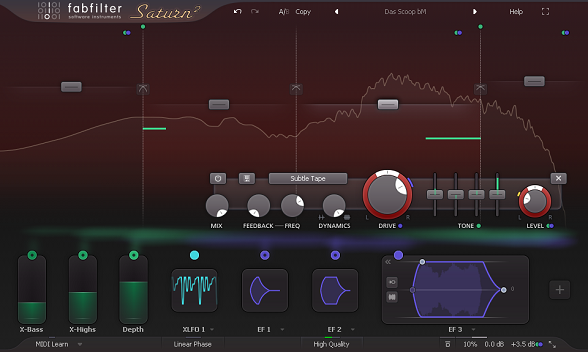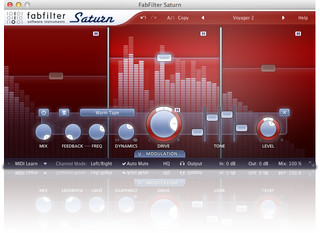

These include new display modes, new algorithms, loudness metering, unity gain and audition limiting, true-peak limiting, higher oversampling and DC offset filtering.
#Fabfilter saturn vs trash 2 manual
But what I will go through in use cases are all of those which the FabFilter Pro‑L 2 manual describes as improvements "added to enhance the workflow" and the sonic benefits that follow from these improvements. There are a number of differences between Pro‑L and Pro‑L 2 which I will not be able to cover in this review for reasons of space, including features such as support for up to 7.1 surround formats, and external side-chain limiting. I didn't use it exclusively, and over the past couple of years, more recent offerings have outgunned it in terms of flexibility and raw power - but then a few months ago, Pro‑L 2 landed in my DAW. This was the original FabFilter Pro‑L, which had preset a profile called 'Jazzy, Spacious, Dynamic and Loud' and which, with a bit of tweaking and just moderate levels of limiting, could actually give a positive lilt to the kind of the projects I was then working on. This was a shame, as my bread and butter work in those days was almost entirely classical, jazz and acoustic music, and I was surprised and delighted when around seven or eight years ago I discovered a limiter that could add the right sort of liveliness there, too. When I first started mastering, the go-to 'pro' limiter - a digital outboard unit - was better at helping the first kind than the second. Of course that's an exaggeration, and there are some kinds of music that seem more fully alive with the right kind of pumping and others than benefit from some mild limiter-induced tightness or excitement. Having spent hours listening carefully on a superb monitoring system, adjusting EQ and compression for absolute sonic optimisation, perhaps using state-of-the-art analogue and digital equipment, the mastering engineer then has to sit down with a relatively inexpensive plug-in, and in the service of mere loudness, try not to undo any of the previous good work. Limiting is one of the aspects of mastering that I look forward to the least. My own short list of limiter desiderata would include: pristine sound, an intelligent ergonomical interface, tweakability when needed, and - combining all three - a set of basic limiting profiles from which to build personal preferences. This means that the kind of demands made on a modern mastering limiter are no longer such that the loudest wins the day: the criteria and the market have become much more varied.


In my own mastering facility we are seeing an increasing number of projects where the final delivery format is for streaming and vinyl only, with CD replication not the front-runner that it used to be. I would be very wary of saying that the loudness wars are really, truly over and gone - there may well be pockets of resistance in far-flung places of the musical universe - but over the past few years there has been a definite general trend towards moderation, helped enormously by the resurgence of vinyl and by the loudness normalisation enforced by streaming services.
#Fabfilter saturn vs trash 2 software
It's a sign of the times that reviews of software mastering limiters just four or five years ago would mainly have judged them on how well they made things loud, and yet today I am reviewing a limiter which I rate highly partly because of how well it allows excellent masters to be made quieter. FabFilter have reinvented their Pro‑L limiter for the new world of loudness normalisation.


 0 kommentar(er)
0 kommentar(er)
